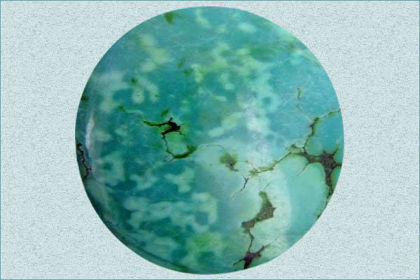Traces of copper are what give turquoise its distinctive blue color

Traces of Copper: Unveiling Turquoise’s True Blue Beauty

Turquoise, the alluring gemstone cherished for centuries, possesses a magical allure that captivates beholders with its vibrant blue hue. But have you ever wondered what exactly gives this remarkable gem its distinctive color? The answer lies in a fascinating scientific fact that traces of copper are what grant turquoise its mesmerizing blue traits.
Copper, a versatile metal known for its excellent conductivity and corrosion resistance, plays a crucial role in many aspects of our daily lives. However, its significance extends beyond technological applications—it also contributes to the striking visual appeal of turquoise gemstones. So, let’s dive into the intriguing relationship between copper and turquoise and uncover the secrets of their unique bond.
Turquoise is an opaque gemstone that belongs to the phosphate mineral group. Its captivating blue color can range from a pale sky blue to a deep greenish-blue, resembling the vast expanse of the ocean. These remarkable color variations can be attributed to the varying levels of copper present within the gemstone.

The formation process of turquoise begins in arid regions, where water seeps through mineral-rich rocks and interacts with copper deposits. Over thousands of years, this slow chemical reaction creates a captivating mix of copper, aluminum, and phosphorus, giving birth to the alluring gemstone we know as turquoise.
Through its atomic structure, copper absorbs specific wavelengths of light and reflects others, predominantly in the blue region of the visible spectrum. This selective absorption and reflection of light result in the gemstone’s iconic blue color appearance. In simpler terms, the presence of copper traps specific colors within turquoise, giving it a mesmerizing blue hue.
The higher the concentration of copper within the turquoise, the more intense and vivid the blue color becomes. If copper is present in lower amounts or absent entirely, the gemstone’s color may shift towards shades of green, as seen in some varieties of turquoise. This incredible versatility adds to the allure of turquoise, allowing it to cater to various preferences and styles.
Apart from its captivating beauty, turquoise has been a symbol of wealth, protection, and spiritual well-being in many cultures throughout history. It has been revered by ancient civilizations, such as the Egyptians, Persians, and Native Americans, who believed in its healing properties and ability to ward off evil spirits. Even today, turquoise continues to be cherished, adorning jewelry and decorative items worldwide, serving as a timeless testament to its enduring charm.
In conclusion, the captivating blue color that distinguishes turquoise from other gemstones can be credited to the presence of copper within its atomic makeup. The combination of copper, aluminum, and phosphorus creates a unique chemical composition, resulting in a stunning spectrum of blues. From its ancient origins to its modern-day significance, turquoise remains a timeless gemstone, captivating hearts and unlocking the door to a world of beauty and mystery.
Source:
ThoughtCo - Unusual Science Facts and Trivia
Tags
Share
Related Posts
Quick Links
Legal Stuff

